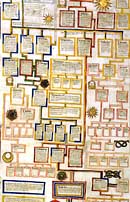History
- Historical Overview
- Life of Edward IV
- Politics in 1460
- "British" History in the Fifteenth Century
- Propaganda in the Wars of the Roses
- Other Genealogies
- Heraldry in the Manuscript
- Banners
- Badges
- The Images and Their Illustrators
Historical Overview
The Family Tree: Roots of the Wars of the Roses: In the middle of the fifteenth century Henry VI, son of the great king Henry V, suffered a mental collapse and the governance of England was turned over to his cousin Richard, duke of York.
Henry's grandfather, Henry IV, had usurped the throne from Richard II and based his claim on being descended from the third surviving son of Edward III through direct male descent. Richard, duke of York, on the other hand, claimed descent from Edward III's second surviving son — but through the female line. Claims and counterclaims turned to the clashes of arms we now call the Wars of the Roses, and Richard, duke of York was killed in battle on December 30, 1460. His son, the eighteen-year-old Edward, Earl of March (tall, blond, handsome, and eligibly single), took up the cause.
Edward defeated the forces of Henry VI in two brilliantly-fought battles and assumed the throne on June 28, 1461. Unfortunately for Edward, Henry VI was still very much alive, and so were many nobles still loyal to Henry.
So, who was the rightful king of England? This gripping question depended on the legitimacy of descent through the female line — a claim that Henry V had advanced to justify his invasion of France, but which would paradoxically have barred him from claiming the very throne he occupied.
Additional web links:
Visit Britannia.com's Monarchs of Britain or Britannia page for brief biographies of medieval English kings
Use the University of Hull's Royal Genealogy Database to explore the overlapping family relationships of medieval English kings and nobility (like most genealogy databases, this is a work in progress and is regularly expanded or corrected)
The Life of Edward IV

Tinted pen-and-ink illustration of Edward IV from the Edward IV Roll
Edward IV was born on April 28, 1442, the eldest son of Richard, duke of York and Cecily Neville. He was born in Rouen, France, where his father was serving as King Henry VI's Lieutenant-General. He was created Earl of March about September 1445.
Because his father was involved in the political turmoil of the 1450s, Edward himself first appears on the political stage at the age of ten, marching at the head of an army to free his father from captivity. After his father's forces were routed at Ludlow in 1459, Edward accompanied his cousins Richard, earl of Warwick and Richard, earl of Salisbury to Calais. At this point Edward emerges as a political figure in his own right, playing a key role in the invasion of England and the capture of Henry VI at the battle of Northampton in the summer of 1460.
Following his father's death at Wakefield (December 30, 1460), Edward rallied the Yorkist troops to spectacular victory at the battle of Mortimer's Cross (February 2-3, 1461). He assumed the throne March 4, 1461, won a second and decisive victory at the Battle of Towton (March 29, 1461), and was crowned king on June 28, 1461. The Edward IV Roll was quite possibly commissioned between March 4 and June 28 or shortly thereafter.
Despite some Lancastrian attempts to regain the throne in the early 1460s, Edward settled into a largely peaceful reign. His political alliance with the powerful magnate Richard Neville, Earl of Warwick ("the Kingmaker") was strained, however, when Edward secretly married an impoverished Lancastrian widow, Elizabeth Woodville, in 1464. This clandestine marriage thwarted Warwick's hopes for a royal alliance with France. Relations were further strained when Edward favored an alliance with France's adversary, the Duchy of Burgundy.In 1469 Warwick entered into an alliance with the Lancastrian forces and in 1470 was successful in reinstating Henry VI on the throne. Edward and his brother Richard, together with other Yorkist adherents, fled to Burgundy, where they gathered mercenaries and returned to England in the spring of 1471. In two hard-fought battles, Barnet and Tewkesbury, Edward delivered the final blow to the House of Lancaster. Warwick was killed during the Battle of Barnet, Henry VI's only son Edward of Lancaster was slain during or immediately after the battle of Tewkesbury, and Henry VI himself met his end, probably at Edward's orders, in the Tower of London shortly thereafter.
From this time until his death, Edward ruled with little opposition. He mounted an invasion of France in 1475, but accepted a treaty and a financial settlement in lieu of a war. In 1477, Edward accused his brother George duke of Clarence of treason. George was executed in February 1478, and rumor had it that he was drowned in a barrel of malmsey wine, a rumor immortalized in Shakespeare's Richard III. In the early 1480s, England was involved in a series of border skirmishes with the Scots, a campaign Edward entrusted to his remaining brother, Richard, duke of Gloucester.
Edward was a vigorous, handsome and charming man and a charismatic leader by popular accounts. As his biographer, Charles Ross, describes him, "He was clearly a man of considerable intelligence, equipped with a particularly retentive memory. He had considerable personal charm and affability and by temperament was generous, good-natured and even-tempered. Consistently courageous, he had great confidence in himself and the capacity to inspire it in others, and from early in his career showed natural gifts of leadership." His contemporaries described him as handsome, and when his coffin was opened in 1789 his skeleton found to measure 6'3-1/2". He was not a particularly scholarly man, although like many of his contemporaries he ordered lavish manuscripts for his personal library, nor was he especially pious or devout. He enjoyed the pursuits of ceremony and display (especially lavish dress), hunting, feasting, and the company of women. His court borrowed heavily from the culture of the Burgundian court, where his sister Margaret presided as Duchess of Burgundy.
When Edward died, on April 9, 1483, he left behind a widow and seven surviving children — two sons and five daughters. After two months of political upheaval, in which Edward's widow and her supporters were involved in a struggle with Edward's brother for control of the government, Edward's son was set aside and his brother Richard assumed the throne as Richard III. The fate of Edward's sons is a hotly debated mystery to this day. Following the death of Richard III at the Battle of Bosworth Field in 1485, Edward's eldest daughter Elizabeth became the queen of King Henry VII.
Further Reading
- Keith Dockray, Edward IV: A Source Book. Stroud: Sutton Publishing, 1999. Readings from contemporary sources with commentary and analysis.
- Charles D. Ross, Edward IV. London, Eyre Methuen, 1981. Now available in paperback as part of the Yale University Press monarchs series. The standard biography.
Edward IV's lifetime spans the principal events of the Wars of the Roses. There are several excellent reviews of the political and military history of the time, including the following:
- Boardman, Andrew W. The Medieval Soldier in the Wars of the Roses. Stroud: Sutton Publishing, 1998.
- Dockray Keith, Henry VI, Margaret of Anjou and the Wars of the Roses: A Source Book. Stroud: Sutton Publishing, 2000.
- John Gillingham, The Wars of the Roses, Weidenfeld and Nicolson, 1981.
- Anthony Goodman, The Wars of the Roses: Military Activity and English Society, 1452-97. New York: Dorset Press, 1981.
- Lander, J. R. The Wars of the Roses. New York: St. Martin's Press, 1990.
- Pollard, A. J. The Wars of the Roses. St. Martin's Press, 1995.
- Charles D. Ross, The Wars of the Roses: A Concise History. London: Thames & Hudson, 1986.
The Political Climate of 1460–61

Nobles and knights in the fifteenth century, from the Edward IV Roll
When Edward IV assumed the throne in 1461, he became the third king to depose a living monarch since the Norman Conquest in 1066. Like his predecessors, he faced the difficult task of reuniting a divided country. But unlike his predecessors, he had to cope with not only a living ex-king but a whole ex-dynasty at liberty and commanding the loyalty of a significant political faction.
The deposition of Henry VI differed from those of Edward II and Richard II in several important respects. Edward II resigned his crown in 1327, ostensibly of his own free will, in favor of his son Edward III and died shortly thereafter at the hands of his captors. Some seventy years later, the childless Richard II also signed away his rights of kingship to Henry IV, and likewise died a few months later.
Edward IV had no convenient legal fiction of the blessing of an abdicating king to strengthen his claim, nor did he have Henry VI in his custody. Instead, Henry VI enjoyed both liberty and relative safety across the border in Scotland, along with his assertive wife and young son and a number of influential nobles who remained loyal to his cause. Both Scotland and France saw an opportunity to weaken their English opponents by encouraging a continuation of civil war, and Edward found himself facing both an actual Scottish invasion and a rumored French one on the eve of his coronation.
With Henry's adherents potentially able to muster so much domestic and foreign support, it was thus vital for Edward to solidify his base of Yorkist supporters, to win over as many neutral nobles and gentry and members of the opposition as possible, and to demonstrate to England's neighbors that the Yorkists had a firm grip on the machinery of government and the support of both the magnates and the people. Without the acquiescence of Henry VI in his own deposition, Edward had an urgent and pressing need to validate his claim to the throne by right of heredity, by conquest, and by divine approval.
Edward's coronation, which he could expect all but his most vehement opponents to attend, was the perfect occasion to state his case to a wide audience by all the means at his disposal. If he could win the support of those who attended his coronation, he could count on them in turn to influence their own supporters when they returned to their homes. To do so, Edward IV and his supporters used every persuasive technique at their command, including the propaganda genealogy.
"British" History in the Fifteenth Century

King Arthur is part of Edward IV's family tree in the Edward IV Roll
Medieval people read history for many of the same reasons we read history today. They read history for its instructive value and for the way it offered examples of right and wrong conduct. They read history for entertainment, and they read history to satisfy their curiosity about the origins of their country and their families.
For people in fifteenth century England, the story of their country's founding was the stuff of legend, closely related both to classical literature and to Bible stories. England, they believed, was founded by Brutus, the great-grandson of Aeneas. After the fall of Troy, Brutus defeated the Greek king Pandrasus, married his daughter, and then wandered across the face of Europe, eventually settling on the shores of
Albion, where the Britons' long and noble history included defeat of the Romans and the exploits of the legendary King Arthur.
This entertaining blend of history, literature, and wishful thinking received one of its most skillful renderings from Geoffrey of Monmouth, whose History of the Kings of Britain (ca. 1138-1139) was accepted by most people as true from the twelfth to the sixteenth centuries. A medieval "best-seller", it was translated from the Latin and summarized into English, Welsh, and Anglo-Norman and survives in many manuscript editions. It also formed the basis of many later medieval "best-sellers" such as Ranulph Higden's Polychronicon and the Brut Chronicles.
By the middle of the fifteenth century the Brut Chronicle had become firmly entrenched as a combination of Geoffrey of Monmouth's History and genealogical updates by various continuators. In its double row of "British" kings the Edward IV Roll lists all the kings mentioned in Geoffrey's History, with with the exception of a small and obscure group who are summarized in one box rather than listed generation by generation.
Further reading:
- William Caxton, The Description of Britain. A modern rendering by Marie Collins of Caxton's updated edition of the Polychronicon. New York: Weidenfeld & Nicolson, 1988.
- Geoffrey of Monmouth, History of the Kings of Britain. There are several inexpensive editions of this work in print; because it is widely studied, it can often be found in used bookstores.
- Antonia Gransden, Historical Writing in England. Volume I, c. 550-c.1307; Volume II, c. 1307 to the early Sixteenth Century. Ithaca, NY: Cornell University Press, 1974 and 1976.
- Antonia Gransden, Legends, Tradition and History in Medieval England. London, Rio Grande: Hambledon Press, 1992.
- Anne E. Sutton and Livia Visser-Fuchs. "History: Its Reading and Making," in Richard III's Books: Ideals and Reality in the Life and Library of a Medieval Prince. Stroud: Sutton Publishing, 1997.
Additional web link: Arthurian passages from Geoffrey of Monmouth's History of the Kings of Britain
Propaganda in the Wars of the Roses
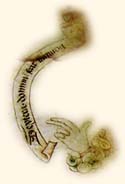
"This is the Lord's doing"— heavenly approbation in the Edward IV Roll
If the kings of the fifteenth century could be said to have one thing in common, it might be the questionable right each had to hold the throne, and a more or less regular series of challenges to the legitimacy of their reigns. England's common people were increasingly interested in political events, keenly aware of their grievances, volatile and responsive to calls to action from the gentry and nobility they served, and credulous to the point of gullibility where rumors were concerned. As a result, insurrections rode on a current of seditious, exaggerated, or frankly fabricated reports, and the royal establishment worked to cut off those rumors at their source by the use of propaganda.
Edward IV's campaign for the throne was accompanied by a concerted propaganda effort that included political songs and poems, newsletters, "bills" or broadsheets hung up in public places pleading the Yorkist cause, the blessing of a Papal legate, sermons in public places, and a wide range of symbolic gestures to demonstrate the legitimacy of Edward's kingship.
Edward himself was quick to seize on symbols to demonstrate divine approval of his cause: a vision of three suns in the sky before the battle of Mortimer's Cross, for example, quickly became, first, the blessing of the Holy Trinity and, later, divine confirmation that Edward should claim the three crowns of England, France and Spain. A vision and a victory so close to Edward's seat of Wigmore, ancestral home of the Mortimers, from whom Edward derived not only the claim to the throne of England but also the rich heritage of Brutus, Arthur and Cadwallader, would have had an almost miraculous symbolism to a fifteenth-century audience, and the Yorkists were happy to capitalize on this fortunate conjunction of tradition and contemporary events.
One important propaganda technique used by the Yorkist was the genealogy demonstrating Edward's descent from the ancient lines of England, France and Wales, and the superiority of his claims to those of Henry VI. Many of these genealogical rolls still survive and show some evidence of an early form of assembly-line production, demonstrating how broadly they were distributed among the nobility and the gentry. Their purpose is to reinforce the legitimacy of Edward IV's kingship through his ancestry, through his prowess as a warrior, and through divine approbation, and their audience appears to have been the nobility and gentry whose opinions could influence and shape "public opinion."
The use of the pedigree to further these aims is not original with the Yorkists. During the 1440s, when it was obvious that the Lancastrian dynasty was faltering, a number of genealogies were created to demonstrate the superiority of the Lancastrian claim to the throne. One surviving example goes so far as to omit Edward III's second son Lionel of Antwerp, duke of Clarence, entirely in an apparent attempt to forestall any claims to inheritance of the throne by descent from an older son of Edward III — since the Lancastrians claimed descent from third son John of Gaunt.
What is unique to the Yorkists, however, is the degree to which they made effective use of imagery to reinforce their claims. In this manuscript, its creators have combined heroic portraiture, quotations from the Vulgate that stress divinely-assisted triumph over enemies and genealogical diagramming that highlights the Yorkist line's ties to a rich legacy of British legend that far surpasses the Lancastrian — as well as genealogical superiority from the more recent past.
For additional reading on propaganda and genealogies in the fifteenth century, see:
- Alison Allan, "Yorkist Propaganda: Pedigree, prophecy and the 'British History' in the Reign of Edward IV," in Charles Ross (ed.), Patronage, Pedigree and Power in Later Medieval England (Alan Sutton/Rowman & Littlefield, 1979).
- Charles Ross, "Rumour, Propaganda, and Popular Opinion," in Ralph A. Griffiths (ed.), Patronage, the Crown, and the Provinces in Later Medieval England (Alan Sutton, 1981).
- V. J. Scattergood, Politics and Poetry in the Fifteenth Century. (Barnes & Noble, 1971).
Similar Manuscripts
Genealogical manuscripts celebrating one's family history are fairly common throughout later medieval England. Many combine the twelfth century Compendium Historia in Genealogia Christi of Peter of Poitiers, a history of the world through the birth of Christ, with the British legends of Geoffrey of Monmouth and with more recent family records.
A fourteenth-century genealogy of the Mortimer family, the "Wigmore Manuscript," contains a Brut, a genealogy of the English kings, and a genealogy of the Mortimer family. It apparently was designed to advance the Mortimer family's claim to the throne of England in the later fourteenth century in preference to that of the descendants of John of Gaunt, presaging the Yorkists' genealogical arguments and appeal to the "British" heritage. Richard II had a pedigree that traced his descent from Noah. During the reign of Henry VI, when his marriage had not yet produced an heir, the succession was again an issue. Concerned that Richard, duke of York might present a strong case to be named the heir apparent, Henry VI's advisors produced a series of pedigrees, including some that omitted the son of Edward III from whom York could claim superior descent. Some surviving pedigrees of fifteenth-century nobility include genealogies of the Percy family, the Nevilles, and a remarkable document celebrating the achievements of Richard Beauchamp, Earl of Warwick.
In the case of Edward IV, the large number of surviving manuscripts suggests that they were consciously produced in large numbers as part of a program to influence the opinion of the nobility and the gentry as well as wealthier merchants, a group who in turn could influence large numbers of friends, supporters, and adherents. Some of these manuscripts are in Latin, others in English, and most of them begin with a version of a standard considerans text, in which the writer explains that considering the difficulty of reading old books and the limited time many have to study them, he will write a brief history of the world from Creation to Christ "to take away length from him that is weary and of little will, comfort and solace in form and figure to the bodily eye, and comfort and grace to them that are well-willed."
To this one fifteenth-century writer adds that "I behold that many men desire greatly to have knowledge of chronicles of kings that aforetime reigned in this land; therefore, I have put the names of them in this work, from Japhet the son of Noah lineally descending to Brutus the first king...and from him to Edward the fourth king of that name after the conquest of England." These manuscripts follow a standard format, with one large illustration showing the Fall of Man, and with minimal illustration thereafter.
Two genealogies depart significantly from this pattern. One is the manuscript explored here. The other, in the British Library, is a typological life of Edward IV. The term "typology" is usually reserved for religious studies, and refers to finding parallels between Old Testament prophecies about the Messiah and the life of Christ. In the "typological life of Edward IV," Old Testament episodes are paired visually with episodes from the life of Edward IV in five pairs of images presented side-by-side. An illustration of Joshua at the battle of Jericho, for example, is paired with an illustration of Edward IV in battle. In another, David the shepherd has a vision of three men, foreshadowing the Trinity. This is paired with Edward's vision of the three suns in the sky before the battle of Mortimer's Cross — and the three suns in turn are paired with the three crowns of England, France, and Spain. In another pair, the infant Moses floating down the Nile in a woven basket foreshadows Edward's escape across the Channel to Calais.
Following the five pairs of illustrations, a genealogy of the kings of England since Henry III takes the form of a tree of Jesse, a popular medieval way of conveying Jesus' pedigree from the House of David and beyond. In this genealogy, though, the culmination is not Christ but Edward IV, who survives the attempts of the usurping Henries to lop off the branch from which he descends.
Further reading
- The best review of genealogies of Edward IV can be found in Alison Allan, "Yorkist propaganda: Pedigree, prophecy and the 'British history' in the reign of Edward IV," in C. D. Ross (ed.), Patronage, Pedigree and Power in Later Medieval England, Alan Sutton, Rowman & Littlefield, 1979. Her notes identify seventeen of these genealogies, but not the Free Library manuscript.
- The quotations from the considerans text and the fifteenth-century continuator are from Bodleian Ms. Lyell 33, transcribed and rendered in modern English by the author.
- The "typological life of Edward IV" is found in British Library Harleian Ms. 7353. Scenes from the manuscript are reproduced in A. J. Pollard, Richard III and the Princes in the Tower, St. Martin's Press, 1991, pages 40, 41 and 53.
Heraldry in the Manuscript

Attributed Arms:
People in the middle ages tended to picture people from their past as looking very much like themselves. This tendency can be seen in the Edward IV Roll, where the sons of Noah are dressed in the height of mid fifteenth-century fashion. Almost at the same time that heraldry was established, arms were invented for legendary figures such as Brutus or King Arthur and his knights. Many of these "attributed arms", such as those of King Arthur, above, can be seen in the Edward IV Roll.
There are many myths and misconceptions surrounding heraldry, the colored emblems transmitted from generation to generation to identify individuals, families, corporations and communities. It has been widely believed, at one time or another, that heraldry has its origins in classical Greece and Rome, or in the runes of the barbarians or the Germanic/Scandinavian tribes, or in the Byzantine or Muslim culture, where it was discovered by the crusaders.
In much of Europe heraldry is regulated by little except custom. Arms identify women, clergy, bourgeois communities, and in some times and places even peasants. As Michel Pastoureau commented, armorial bearings are like business cards — anyone can use them, but not everyone does. In England, on the other hand, use of armorial bearings is restricted to the gentry and is controlled by the College of Arms and the High Court of Chivalry.
Heralds originally carried messages, including declarations of war, and announced at tournaments. As such, they were a bit like modern sports announcers in that they needed to recognize individuals by their coats of arms with speed and accuracy. Over the years both heraldry and the duties of heralds became more complex and more precisely spelled out. Achievements of arms are described in an elegant, economical and supple language called blazon, based on twelfth-century Anglo-Norman French.
By the time the Edward IV roll was created, it was common for kings and nobles to employ the services of skilled heralds, who enjoyed considerable prestige and recognition. The College of Arms was formally established in 1484 by Edward IV's younger brother, Richard III, who granted them a charter and a building in London, Coldharbour, to use for storage of their records. Richard's successor Henry VII seized the building and gave it to his mother; the present charter and building site were given to the College by Queen Mary in 1555.
For additional information on the College of Arms, see their web site.
Further reading:
- Gerard J. Brault. Early Blazon: Heraldic Terminology in the Twelfth and Thirteenth Century with Special Reference to Arthurian Literature. Oxford: Clarendon Press, 1972.
- Boutell's Heraldry, rev. J. P. Brooke-Little. London and New York: Frederick Warne, 1978.
- Michel Pastoureau. (Tr. Francisca Garvie). Heraldry: An Introduction to a Noble Tradition. New York: Harry Abrams, 1997.
- Thomas Woodcock, The Oxford Guide to Heraldry. Oxford University Press, 1990.
The Banners and Shields of the Edward IV Roll
The large opening image of the manuscript shows Edward on a horse with elaborate heraldic trappings — the royal arms of England quartered with those of Castile and Leon, with a central shield showing the imagined arms of Brutus, founder of England. This image is repeated in one of the last banners of the scroll. Two additional shields are shown on either side of Edward IV's head — France, left, and Castile/Leon, right. Below the introductory image and text are two columns showing a total of 54 banners and shields, at the left and right margins of the manuscript.
The banners are overwhelmingly those of individuals or families from whom Edward was descended or, in the case of legendary figures, from whom Edward claimed descent. They present Edward's rich family heritage, especially his connection to the legendary founders of Britain, in a visual format that would have been very compelling to its original audience.
Left

St. George, the patron saint of England. Taken by Edward III as the patron saint of the Order of the Garter, widely seen as a fourteenth-century recreation of King Arthur's Round Table.

Attributed arms, Brutus and Pandrasus. Brutus, legendary founder of Britain, is said to have married the daughter of Pandrasus, a king of Greece. The attributed arms of Brutus — three gold crowns on a blue field — are shown impaling those of Pandrasus

Banner of the Verdon family. The Verdons were distant ancestors of Edward IV. and, by marriage, to one of Edward's most important supporters, the Earl of Warwick ("the Kingmaker").

Badelsmere. Edward IV had a share in the barony of Badelsmere in right of his descent from the Badelsmeres.

The inscription above this banner reads "Leycester" but the arms are those of the Quincys.

Edmund, duke of York, lost his life at the battle of Agincourt in 1415 and is buried in Fotheringhay Church, where Edward IV's father expected to create a family mausoleum.

Warenne Earls of Surrey. Extinct in the male line since 1347, the Warenne earldom was assumed by Richard Fitzalan in right of his wife. His grand-daughter, Joan, was Edmund Langley's second wife.

Llewelyn ap Gruffyd, Prince of Wales. The Yorkists thought of themselves as the successors of the old Welsh princes.

The inscription reads "Domini Hibernie" (Lords of Ireland) but the arms of Ireland at the time were azure three crowns in pale or. The harp did not come into use as part of Ireland's arms until the sixteenth century, although it has appeared in earlier manuscripts as a sort of crest. See also 18R.

Arms of Edmund Crouchback, earl of Lancaster, son of Henry III. When Henry IV usurped the throne from Richard II there was some claim that Edmund was actually the elder son but was passed over because of his deformity — and that Henry IV was the rightful heir of Edmund Crouchback. This genealogy "restores" Edmund to his "rightful" place as the fourth son in pointed repudiation to this claim.

Cinque Ports. Originally constituted as five ports in the eleventh century but consisting of a larger number by the fifteenth, the Cinque Ports formed an arc across southeastern England. The Cinque Ports bore the responsibility of defending post-Conquest England from a European invasion prior to the establishment of the royal navy in 1497. Edward created his cousin and supporter Richard Neville, earl of Warwick, Warden of the Cinque Ports about the time this manuscript was created.

The attributed arms of Brutus, the legendary founder of Britain. These have appeared (2L) impaling those of his father-in-law Pandrasus.

Princes of Wales. In the complex iconography of this manuscript, this shield may carry a double meaning: a reference to Edward as eldest son of the legitimate king (echoing the relationship of the Black Prince to Edward III), and a reference to the Welsh heritage of the Yorkists through the Mortimer line.

King Arthur. This is an unusual version of these attributed arms, which normally carry an ordinary cross and not a cross flory.

Another version of the arms of the Duchy of Cornwall. See 2R.

King Oswald
This seventh century Northumbrian king was renowned for both his piety and his military prowess. His head, together with the body of St. Cuthbert, are now buried behind the high altar at Durham Cathedral.

Dukes of Aquitaine. This is one of the seven principal lines of descent indicated by half-portraits in the manuscript.

The inscription appears to say "Ed... pacifici," which would suggest Edgar the Pacific (reigned 959-975). The arms, however appear to be those attributed to Edward, son of King Alfred.

Possibly Richard, duke of Normandy. The inscription identifies it as Richard, the duke without fear (sine timor). His daughter was the mother of Edward the Confessor (see 23L)

St. Edmund the Martyr. This East Anglian king was killed by Danish invaders in 870 while defending his subjects. After his death his head was miraculously restored to his decapitated body. [more]

De Burgh - Earls of Ulster. Lionel of Antwerp married Elizabeth (Isabella) de Burgh, Countess of Ulster. In 1425 on the death of his mother's brother, Edward's father Richard, duke of York succeeded to the title of Earl of Ulster. (See 22R)
St. Edward the Confessor, whose English/Norman mixed parentage made him sympathetic to Norman interests, to the dismay of some of his English subjects. After his death in 1066 the struggle for the succession culminated in the Norman Conquest. Richard II was particularly devoted to the memory of this saint, as were the first two dukes of York, whose collegiate chapel at Fotheringhay was named the College of the Annunciation and St. Edward the Confessor.

The De Bohun earls of Hereford. Mary de Bohun, younger daughter and coheiress of Humphrey earl of Hereford, Essex and Northampton, was Henry IV's first wife.

The inscription identifies this as William the Conqueror. The usual coat for the Norman kings only had two lions; legend had it that the third was added to the coat of England when Henry II married Eleanor of Aquitaine whose coat had a single lion passant (see 18L). [more]

De Braose (Brewse). Lords of Brecon, ancestors of the Mortimers. See 8R.

Royal arms of England quartered with arms of Castile and Leon, with central shield bearing imagined arms of Brutus. This standard is held by the White Lion of March, a personal badge of Edward IV.
Right

The inscription indicates that these are the attributed arms of the East Saxon king Sebbi. Bede tells that before his death Sebbi saw a vision in which three men in shining garments — probably representing the Trinity — visited him to tell him he would die in three days, without pain. Trinitarian imagery figures in other Yorkist propaganda.

Duchy of Cornwall. According to Geoffrey of Monmouth, the duke of Cornwall was one of King Arthur's most trusted supporters. Since 1337, the Duchy of Cornwall has been held by the heir apparent.

An early version of the coat of arms of the Clares.
In 1189 the legendary William the Marshal married Isabel de Clare, sole heiress of Richard Strongbow de Clare, earl of Pembroke. The makers of this manuscript have telescoped the relationship into a direct link from William the Marshal to Lionel of Antwerp, Duke of Clarence, son of Edward III.

An early coat used by the Lacy family.

Holland earls of Kent. Edmund of Langley, first Duke of York, was married to Joan, daughter of Thomas Holland, second earl of Kent. Additionally, John Neville, half-brother to Edward's mother, married Elizabeth, sister and coheiress of Edmund Holland, fourth earl of Kent.

The arms of Mortimer impaling those of the dukes of Normandy. These arms may be a fifteenth-century conceit symbolizing the union of the Norman with important Welsh lines.

Earls of Chester. A title always held with the Principality of Wales.

Brecknock. The mother of Edmund, first lord Mortimore of Wigmore, was Maude de Braose, Lord of Brecon (Brecknock).

Richard earl of Cambridge, Edward IV's grandfather, executed in 1415 for his role in the Southampton plot against Henry V's life on the eve of the English invasion of France.

This banner is currently unidentified. It is possible that it is an erroneous representation of the arms of the Holy Roman Empire — (or an eagle displayed sable) — to indicate Edward IV's descent from Frederic II of Hohenstaufen.

The coat used by one of the early earls of Northampton. It is a differenced form of the usual Bohun coat (see 24L).

Staple of Calais. The port of Calais plays an important role in Edward's accession to the throne, having harbored him and his supporters in 1459-60. A contemporary manuscript pairs an image of Moses floating in his basket with one of Edward and his supporters sailing for Calais, suggesting that the one event foreshadowed the other.

The inscription indicates that these are the arms of King Ethelbert, but these are not the usual arms attributed to him..

Cadwaladr, the last of the British princes in Geoffrey of Monmouth's History of the Kings of Britain.

Arthur has been associated with two sets of attributed arms; this one carries the inscription "Arthuri melitissimi" above it.

Dukes of Normandy. This is one of the seven principal lines of descent indicated by half-portraits in the manuscript.

This banner is currently unidentified.

Inscription identifies this as "Lords of Ireland." Ireland was important to the Yorkists in two respects. Edward's father Richard, duke of York served as Lieutenant of Ireland under Henry VI and sought refuge there just months before his death in battle. Additionally, Roger Mortimer, fourth earl of March, served as Lieutenant of Ireland and was Richard II's heir-apparent until Mortimer's death in 1398.

The inscription identifies these as the arms of Constantine, emperor of Rome, who in the middle ages was believed to have been descended from Brutus. Constantine's vision of the chi-ro in the sky before battle resulted in his conversion to Christianity and was the first step in Roman acceptance of Christianity as the state religion of the Roman Empire.

Ralph, earl of Mortimer. In 1406 Edward's grandfather, Richard earl of Cambridge, married Anne, sister and coheiress of Edmund Mortimer, fifth earl of March. Edward's claim to descent from the second son of Edward III flows from this marriage. The marriage of Ralph Mortimer, Lord of Wigmore to the daughter of the Welsh prince Llewellyn the Great in the early thirteenth century is the source of the Yorkist link to Brutus, Cadwaladr, and Arthur.

The inscription clearly labels this as Ethelred, but this is also identical to 19L. In neither case does the inscription appear to match any arms attributed to Ethelred.
De Clare and earls of Gloucester. Edward could trace his pedigree back to the De Clare earls of Gloucester through Lionel of Antwerp's wife, Elizabeth de Burgh as well as through the FitzAlans.

St. Louis (King Louis IX). This king, a contemporary of England's Henry III, combined piety, success as a crusader, and keen negotiating skills. He was widely respected by his contemporaries and canonized soon after his death. [more]

De Geneville. Jeanne de Geneville, wife of Roger Mortimer, first earl of March, who led the revolt against Edward II. After Edward's deposition and murder, Roger Mortimer and his mistress, Isabella of France, ruled England in right of the young Edward III, but he was ultimately tried and executed for his part in Edward II's overthrow.

Castile and Leon. Like his predecessors, Edward IV claimed the throne of these kingdoms.

The inscription says "Hampton" but the connection to Edward IV's pedigree, real or imagined, remains to be identified.

The royal arms of England. It is probably not an accident that this standard is held by the White Hart, the best-known personal badge of Richard II.
Badges and Devices
In addition to arms, the later medieval royalty, nobility and gentry used a variety of badges and devices. The Edward IV Roll contains Edward's own badges as well as some of his ancestors or supporters.

Sun, Fetterlock, Rose
These three badges are repeated in a regular rotation throughout the length of the manuscript. The sun was used as a badge by Richard II and was adopted by Edward IV as the sun in splendor after the battle of Mortimer's Cross because of the three suns seen in the sky just before the battle. The white rose (discolored in many places on this manuscript) was used by many members of the House of York, but it achieved its real prominence with Edward IV; it is described more fully below. The fetterlock is a badge taken by Edward Langley, first duke of York, and was used by Edward's father, together with a falcon.
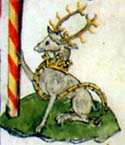
White Hart
The white hart badge was used by Richard II, and can be seen most famously in the Wilton Diptych, a painting in the National Gallery, London. In this painting, Richard wears a cloth of gold robe with a hart pattern as well as an elaborate white hart jewel. The painting also depicts the Virgin Mary surrounded by thirteen angels, all wearing the white hart badge. The white hart can be found repeatedly in the Edward IV Roll, probably to reinforce Edward's right to claim the throne as the legitimate heir of Richard II via the Mortimers.

Black Bull of Clare
The black bull is associated with the honor of Clare. It was Lionel of Antwerp, duke of Clarence, the second son of Edward III, that gave Edward IV the senior claim to the throne. Additionally, the intermarriage of the Clare and Mortimer lines allowed Edward to claim the British heritage of Brutus, Arthur, and Cadwalader.

White Lion of March
A badge of the Mortimer Earls of March, this was the badge that Edward used throughout his life. It was common for his adherents to wear gold livery collars (neck chains) with alternating links of suns and roses, with a single white lion at the center. An example can be seen in the "Donne Triptych," a painting by Hans Memling in the National Gallery, London.

Falcon, Fetterlock, Rose, Cross of St. George
This symbolically complex and unusual image blends the emblems and badges of England, Richard, duke of York and Edward IV. Most falcon-and-fetterlock images show the falcon contained within the fetterlock. Here the falcon perches atop the fetterlock, while the rose-en-soleil it contains has at its center the cross of St. George, patron saint of England and one of the particular saints of the House of York.
Stafford Knot

Bourchier Knot

Both of these knots are associated with families who intermarried with the Yorkist dynasty
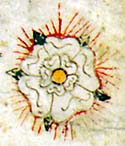
Rose-en-Soleil
The rose has had a number of meanings in the middle ages. Both white and red roses have been associated with Christ and the Virgin Mary. Edward used the white rose as a badge and was called "the Rose" or "the rose of Rouen" in propaganda documents of the day, such as this one: "Lette us walke in a newe wyne yerde, and lette us make us a gay gardon in the monythe of marche with thys fayre whyte ros and herbe, the Erle of Marche." The origin of the relationship of the white rose with the House of York is obscure. C. W. Scott-Giles, in Shakespeare's Heraldry, claims that the white rose was "originally a badge of the Mortimer earls of March, and was used by Earl Roger, who died in 1369." Others have suggested that the white rose is "by right of the Castle of Clifford." Edward is descended from Maude Clifford, but how the badge came to be associated with the castle is likewise unknown. Edward combined the rose and the rays of the sun in the rose-en-soleil, which appears in regular rotation with the sun and fetterlock in the manuscript. It also appears, in a larger version, along the left and right margins of the top half of the manuscript, alternating with the banners and accompanied by Edward's motto, comfort et liesse (comfort and joy).
- The "white rose" quotation is from V. J. Scattergood, Politics and Poetry in the Fifteenth Century (New York: Barnes & Noble, 1971), p. 189.
The Images and Their Illustrators
There are five major illustrations in this manuscript, in addition to more than 50 shields and banners, several beasts, and dozens of roses, suns, and fetterlocks. The art historian Kathleen L. Scott has suggested that the major illustrations were probably allotted to three different artists.

The equestrian portrait of Edward IV sets the tone of the rest of the manuscript, with symbols of kingship and divine intervention surrounding the horse and rider. Edward and the face of his horse are done in delicate pen-and-ink with faint washes added, with brilliant colors used for the horse-trapper. Tinted pen illustrations enjoyed considerable popularity in England during the later fifteenth century (for two well-known examples of pen illustrations in fifteenth-century genealogy rolls, see the Rous Rolls and the Beauchamp Pageant, both illustrated in A. J. Pollard, Richard III and the Princes in the Tower
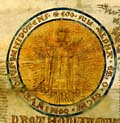
The first roundel, God in Majesty, may also be the work of the first artist. It is a pen-and-ink drawing over which gold leaf has been laid. Scott notes a similarity between this and one other genealogical roll, but it is otherwise an unusual subject for these manuscripts. The presentation of God within a sunburst is echoed throughout the manuscript by the repetition of Edward IV's badges, the rose-en-soleil and the sun in splendor.
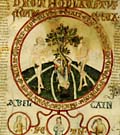
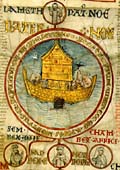
The next two roundels (the Fall of Man and Noah's Ark) as well as the small roundels beneath them have been assigned to a second illustrator by Scott. The Fall of Man is the standard opening roundel of many of the other genealogical rolls, as well as of histories of the world from Creation to Christ that draw on the same text. Perhaps because the illustrators had created so many of these roundels, the treatment of the subject in many of the other rolls is much more polished than this rather crude and dark roundel. Iconographically, however, this roundel is unusual in three respects: the garden includes a medieval fountain, from which four streams of water representing the four rivers of the Garden of Eden pour forth; divine intervention is represented by rays emanating from a nimbus (upper left), and the serpent, instead of being head-up as in the "assembly line" roundels, is being driven headlong into a pit. Scott comments, "[this] may represent the intervention of the (royal) patron to emphasize the theme of a God who sides with the virtuous and takes action against the iniquitous."
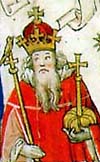
Scott assigns the half-figures of the Kings and Princes to a third illustrator. These half figures, appearing behind a low wall, comments Scott, "are more accomplished, more decided in the delineation of faces and figures and in the application of color than the Adam and Eve artist."
Much of the material in this section is adapted from two articles by Kathleen L. Scott:
- Later Gothic Manuscripts, 1390-1490, A Survey of Manuscripts Illuminated in the British Isles, vol. 6 (London: Harvey Miller, 1996). vol. 2, pp 288-89, no. 104; ills. 393, 394
- "The Edward IV Roll." In James Tanis and Jennifer Thompson (eds.) Leaves of Gold: Treasures of Manuscript Illumination from Philadelphia Collections (Philadelphia, Philadelphia Museum of Art, 2000, in preparation).
See also:
- J. J. G. Alexander, Medieval Illuminators and Their Methods of Work. New Haven and London: Yale University Press, 1992.
- Faye and Bond. Supplement to the Census of Medieval and Renaissance Manuscripts in the United States and Canada. Originated by C. U. Faye; continued and edited by W. H. Bond. New York: Bibliographical Society of America: Distributed by Klaus Reprint Co., 1962.
- P.W. Hammond, A. F. Sutton, and L. Visser-Fuchs, "The Reburial of Richard, Duke of York, 21-30 July 1476," The Ricardian: Journal of the Richard III Society, Vol. 10 (December 1994) , pp. 122-65, note 58.
- A. J. Pollard, Richard III and the Princes in the Tower, Stroud and New York: Sutton Publishing and St. Martin's Press, 1991.
- Anne F. Sutton and Livia Visser-Fuchs, "Richard III's Books: Ancestry and 'True Nobility,'" The Ricardian: Journal of the Richard III Society, Vol. 9 (December 1992), pp. 343-58, note 18.
Links
These sites are known for their combination of content and links to other worthy sites. All have been put together by the voluntary efforts of medieval scholars:
- The Internet Medieval Sourcebook (Paul Halsall, hosted by Fordham University)
- The Labyrinth (Georgetown University)
- Netserf (Beau Harbin, formerly hosted by Catholic University)
See also The Consortium for the Teaching of the Middle Ages (TEAMS).
Medieval Manuscripts: Collections of Images on the World Wide Web
- Leaves of Gold: Treasures of Manuscript Illumination from Philadelphia Collections. An online version of the spring 2001 exhibition at the Philadelphia Museum of Art.
- Bibliotheca Schoenbergensis: Images from the collections of University of Pennsylvania alumnus Lawrence T. Schoenberg.
- The Electronic Beowulf Project: The online help pages for a groundbreaking CD-ROM based project that allows electronic access to the only surviving copy of Beowulf while safeguarding the precious and fragile original.
- The Digital Scriptorium: A prototype of a project to create a union catalog and image archive for medieval manuscripts.
- Bodleian Library, University of Oxford, medieval manuscripts images
See also Netserf's listing of collections of medieval manuscript images and The Labyrinth's Arts and Architecture section.
Medieval Manuscripts: Glossary of Terms
- University of Pittsburgh — a comprehensive, illustrated glossary of terms. Uses frames.
Other Links of Interest
- The St. John Bible project — the first handmade Bible of the new millennium

